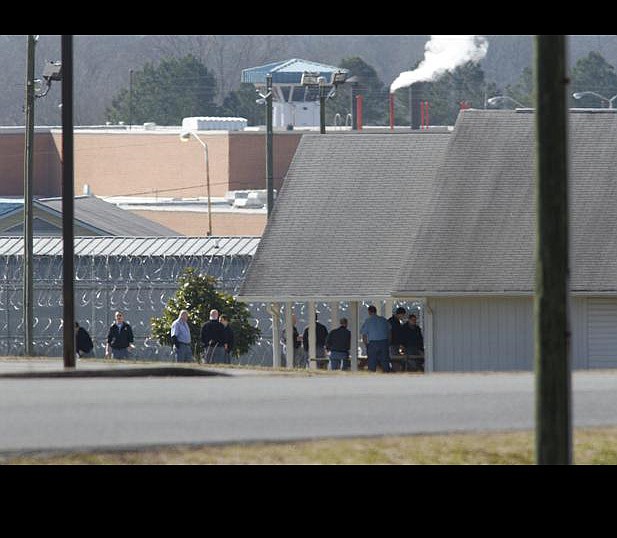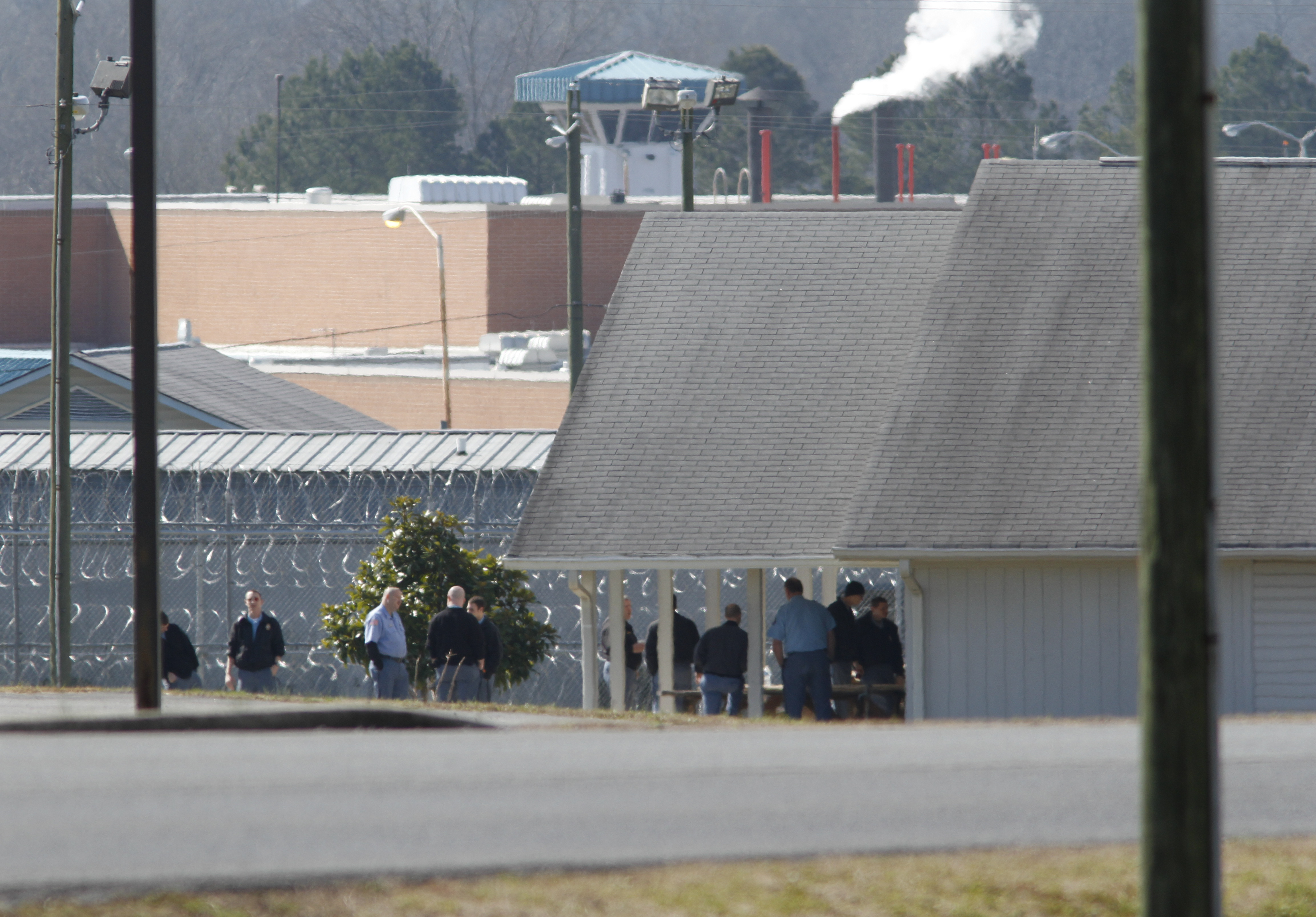BY THE NUMBERS2012 reports show the best and worst numbers for maximum-security prisons in Georgia:Highest* Cellphones and weapons seized: 866 cellphones, 2,248 weapons, Smith State Prison* Inmate-on-officer assault: 251 incidents, Georgia State Prison* Inmate-on-inmate assault: 185 incidents, Georgia Diagnostic and Classification Prison* Officer use of force: 266 incidents, Georgia Diagnostic and Classification Prison* Staff shortage: 21 percent average, Telfair State Prison* Deaths: Two inmates, one officer, Telfair State PrisonLowest* Inmate-on-inmate assaults: 15 incidents, Augusta State Prison* Inmate-on-officer assaults: 12 incidents, Hays State Prison* Staff shortage: 4.12 percent, Phillips State PrisonSource: Georgia Department of Corrections
Webcast
This story is featured in a TimesFreePress newscast.
Before the killing spree began at Hays State Prison, there was Telfair.
This maximum-security state prison in Helena, Ga., reported a three-month rash of stabbings that ended last October with two inmates and Corrections Officer Larry Stell dead. He was the first state corrections officer killed in a decade.
Farther south in Georgia, six prisoners have been killed in two years of escalating violence at Smith State Prison.
This year, the Department of Corrections is funneling more money into security upgrades and scrutinizing Hays after four prisoners were killed in a two-month span. Yet numbers suggest that Georgia prisons across the state are growing more violent.
Three times as many prisoners were killed in state prisons last year than 10 years ago, state figures show. And the violence and the conditions that foster it seem to show no sign of subsiding.
• By Feb. 10, three inmates already had been killed this year, putting the system on pace to exceed last year's nine deaths. That was the highest annual total in at least a decade.
• Contraband weapons and cellphones are considered bellwethers of crime inside prison walls. Last year, more than 5,000 cellphones and 11,000 weapons were seized at the state's 12 maximum-security prisons.
• Monthly shortages of correctional officers ran as high as 30 percent at some prisons.
And that is all against a backdrop of growing gang influence and prisoner overcrowding fed by the closure of seven prisons in five years.
Since July, nine inmates and an officer were either killed at the hands of gang members or the victims were part of a prison gang, according to the Georgia Bureau of Investigation. Of the three deaths so far this year, two are connected to Hays State Prison, but all have been gang-related.
Corrections administrators say inmates are getting more violent, and they blame the killings on easier access to cellphones.
And indeed, homicides in state prisons nationwide rose from 39 in 2001 to 67 in 2010, according to the U.S. Bureau of Justice Statistics.
But Georgia recorded a disproportionate number of those killings -- seven. That's more than 10 percent of the total, and the fifth-highest number of prisoner deaths by homicide in the nation.
In fact, inmate killings in Georgia prisons spiked in 2009 even though the state's prison population began to decline.
Outside experts say that prisoners will always have a tendency toward mayhem, but it's no secret how to run a viable, controlled prison system.
"It's not a mystery what they should be doing," said Helen Eigenberg, a University of Tennessee at Chattanooga criminal justice professor. "When you see spikes in assaults, high levels of contraband, lots of [officer] turnover, those are serious signs of a serious problem."
Perhaps in a nod to fundamentals, Commissioner Brian Owens this year changed his No. 1 priority for the Georgia Department of Corrections. In 2012, the first goal was to optimize bed space. For 2013, Owens changed the top priority on his list to: "operating safe and secure facilities."
That wasn't even on the list in 2012.
•••
The deaths of four Hays State Prison inmates in seven weeks put the facility under a media microscope. Chattanooga Times Free Press reporting revealed persistent staff shortages that reached 17 percent, a drastic climb in weapons and cellphones inside the prison and locks that had been broken since at least 2010, allowing prisoners to roam.
Employees suggest these contributed to the breakdown in security and, ultimately, three homicides at the prison between Dec. 19 and Jan. 18. A fourth Hays inmate was killed Feb. 5 shortly after he was taken to Georgia's highest level security prison in Jackson.
Yet killings have been rising across the state. Since 2010, 26 inmates have died at the hands of other prisoners.
The GBI, which investigates the killings, is tracking a rise in gang-related deaths.
Four gang members are suspected of robbing and killing inmate Laderick Chappel at Georgia Diagnostic and Classification Prison in August. A Bloods gang member has been charged in the killing of Officer Stell. No one has been arrested for killing Derrick Stubbs, who was found dead in protective custody at Hays, but the GBI suspects that the killers were gang members.
The Department of Corrections declined to comment on the gang violence.
But monthly reports obtained from the GDC give a snapshot of the state's maximum-security lockups. The numbers show dangerous rises in contraband weapons and cellphones and hundreds of attacks on inmates and guards statewide.
Smith State Prison in Glennville, Ga., was where the highest levels of contraband were seized in 2012 -- 866 cellphones and 2,248 weapons. On one day in May, guards found 101 cellphones that had been thrown in the prison's razor-wire fence. In the same month, seven visitors were arrested for attempting to smuggle in contraband.
Assaults on other prisoners and on the staff also spiked last year at several prisons.
Georgia State Prison documented 251 inmate assaults on officers, an average of 21 assaults a month. And officers were documented using force 265 times in 2012.
In the Georgia Diagnostic and Classification Prison, which has the highest security in the state as well as the largest inmate population, officials reported the second-highest number of prisoner-on-officer assaults -- 86 assaults in a year.
Staff shortages were also high at some prisons. While Hays State Prison reported a peak guard shortage of nearly 16 percent in August 2012 -- it has since risen to 17 percent in February -- it wasn't the worst in the state.
At Telfair, where two inmates and an officer were killed between August and October, the guard shortage during that period ranged from nearly 15 percent to nearly 20 percent. But fully 30 percent of the guard positions were vacant last January. And in fact, the guard shortage at Telfair averaged more than 20 percent for the first six months of 2012.
For the year, the corrections department spent $1.1 million in overtime at that prison alone to compensate for the staff shortages.
Guard shortages make it more difficult to keep control of the prisons and do basic security such as regular shakedowns, according to Sarah Geraghty, an attorney with the nonprofit Southern Center for Human Rights.
After one prisoner death each at Valdosta and Smith and multiple prisoner deaths at Telfair and Hays, guards found more contraband the month after the killings. In some cases, the numbers of cellphones and weapons seized doubled, suggesting that regular shakedowns weren't being conducted before the killings, experts say.
The upward trend in gang rapes, prisoner assaults and even instances of torture is alarming, Geraghty said.
"We have never seen violence in GDC like we've seen in the last 11/2 years," she said.
•••
Commissioner Owens said in a document outlining the department's strategic plan starting this year that "inmate access to and use of cellphone technology poses the latest and most significant threat to institutional safety and security."
He said the department has adopted a strategy that is focused on cellphone interdiction and preventing contraband from entering the prisons.
Last year, state lawmakers passed a resolution asking Congress to pass a law allowing cellphone jammers inside prisons, which would overturn a 1934 telecommunications law prohibiting those devices. But so far nothing has happened.
State Rep. Jay Neal, R-LaFayette, is chairman of the House committee that oversees corrections. Neal said prisoner access to cellphones is why the Department of Corrections' efforts to fight the gang problem isn't working anymore.
"They used to be able to break up gangs from one prison to another, [but] when you have them communicating through cellphones, it's more and more difficult," he said.
Atlanta defense attorney McNeill Stokes, who has sued the Department of Corrections about 100 times in the past 10 years on behalf of inmates, said he has noticed a shift from guards' use of force to prisoner-on-prisoner violence.
A decade ago, lawsuits against the department tended to deal with guards beating inmates and serial rapes at a women's prison, Stokes said. Now, he said, he gets calls about extortion and gang beatings and killings.
"There are ways to control gang violence," Stokes said. "They're just not doing it."
Under an initiative by Gov. Nathan Deal that was sponsored by Neal, the Corrections Department since 2010 has pumped extra resources into an effort to reduce lengthy sentences for less violent offenders. Now prison populations in Georgia that historically have been higher than most of the nation have started to decrease.
In 2009, state prisons held 59,650 inmates. In 2012 that had declined to 57,780 inmates.
At the same time, the department has closed six minimum- or medium-security prisons and one women's maximum security prison, saving more money.
But corrections employees say this meant some of the higher security prisons where more violent prisoners are housed, such as Hays, had to take in more prisoners.
At Hays, current and former guards also blame corrections administrators for the increase in violence. They point to poor leadership decisions, such as letting inmates control the dorms, not conducting regular shakedowns because of staff shortages or warning inmates in advance of searches and ignoring gang problems.
Bob Digges, a retired Hays officer whose primary job was collecting gang intelligence, said something is wrong at the prison today.
"If you've got that many gang-related killings and it's that easy to get access [to cellphones], there's a problem someplace," he said.
California corrections consultant Daniel Vasquez said all these warning signs added together at Hays show the federal government should get involved.
"If all that is happening, you have a morally corrupt Department of Corrections," he said.
One lawmaker asks why the state continues to pump more than a billion dollars a year into corrections while the numbers show the prisons are growing more violent.
State lawmakers have been funneling money to the Department of Corrections for multiple rehabilitation programs, said state Rep. Tom Weldon, R-Ringgold, who is on the appropriations public safety committee.
Yet, he said, "all that other stuff doesn't matter unless you have law and order."
Contact staff writer Joy Lukachick at jlukachick@timesfreepress.com or 423-757-6659.

